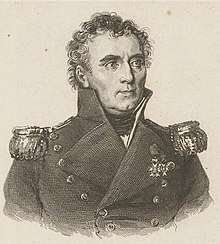Louis-Isidore Duperrey
This article needs additional citations for verification. (February 2014) |
Louis-Isidore Duperrey | |
|---|---|
 | |
| Born | 21 October 1786 Paris, France |
| Died | 25 August 1865 (aged 78) Paris, France |
| Nationality | French |
| Occupation(s) | Naval officer, explorer |
Louis-Isidore Duperrey (21 October 1786 – 25 August 1865) was a French naval officer and
Biography
Early life
Louis-Isidore Duperrey was born in 1786.
Career
He joined the navy in 1802, and served as marine hydrologist to
During the voyage the ship spend two weeks in the Bay of Islands in the north of New Zealand in 1824 and visited for ten days on l'île d'Oualan,[1] now Kosrae, contemporary Federated States of Micronesia, that same year.[2] On the return voyage to France the ship sailed through the Ellice Islands (now known as Tuvalu).[3]
He was the first to put together on a map the whole Gilbert Islands archipelago, which are now part of Kiribati (with the name given to it by Admiral Krusenstern).[3] He was elected a Foreign Honorary Member of the American Academy of Arts and Sciences in 1861.[4]
Death
He died in 1865.
Legacy
The Australian eastern three-lined skink, Bassiana duperreyi (Gray, 1838), was named in his honour.[5]
Also 2 plant
See also
References
- ISBN 978-0794600921.
- ^ "Coquille". Early shipping in New Zealand waters. Archived from the original on 10 November 2013. Retrieved 10 November 2013.
- ^ a b Chambers, Keith S.; Munro, Doug (1980). "The Mystery of Gran Cocal: European Discovery and Mis-Discovery in Tuvalu". The Journal of the Polynesian Society. 89 (2): 167–198.
- ^ "Book of Members, 1780–2010: Chapter D" (PDF). American Academy of Arts and Sciences. Retrieved 9 September 2016.
- ISBN 978-1-4214-0135-5. ("Duperrey", p. 78).
- ^ "Duperrea Pierre ex Pit. | Plants of the World Online | Kew Science". Plants of the World Online. Retrieved 2 September 2021.
- ISBN 978-3-946292-26-5. Retrieved 1 January 2021.
- ^ "Duperreya Gaudich. | Plants of the World Online | Kew Science". Plants of the World Online. Retrieved 26 May 2021.
- ISBN 978-0-8493-2676-9.
